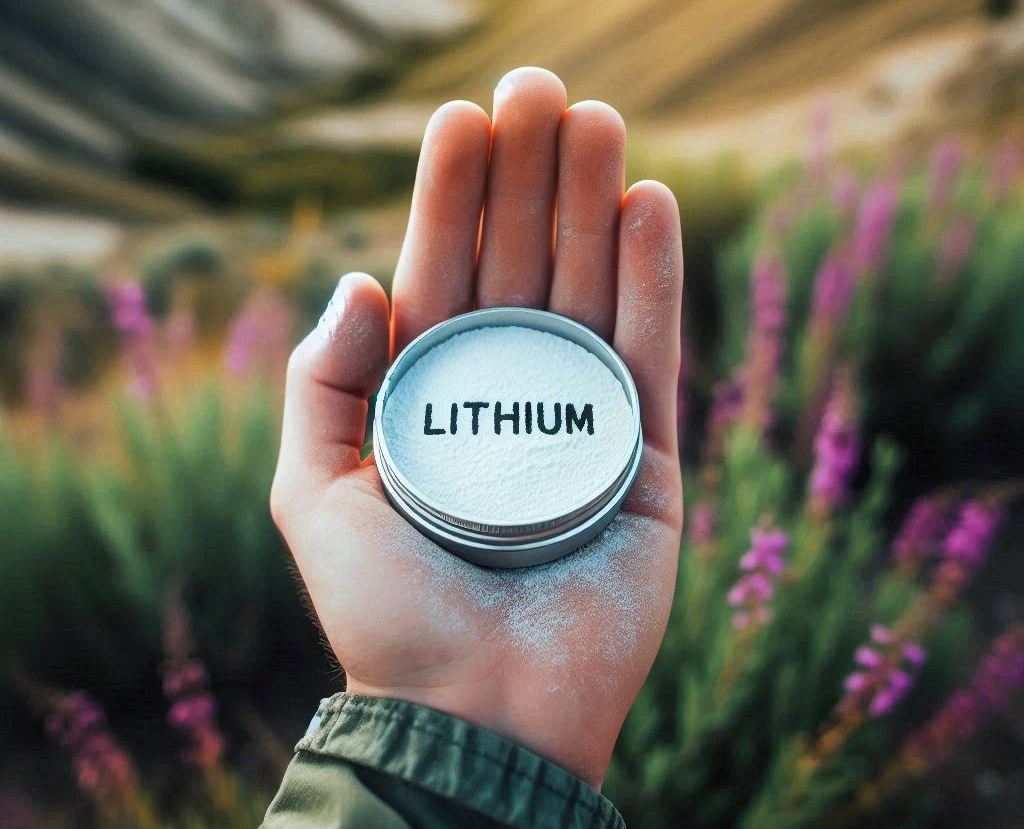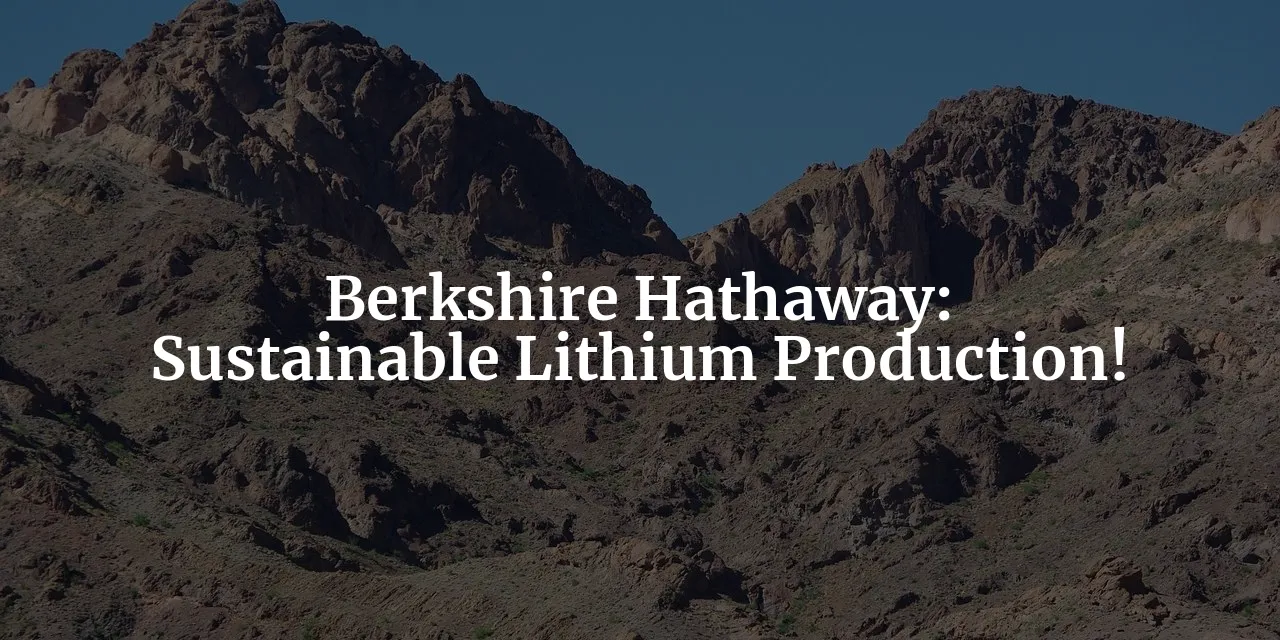Tags: Oxy / BHE / ESG / Innovation
This fanpage is not officially affiliated with Berkshire Hathaway: Disclaimer
Lithium might the gold of the clean energy revolution because of its use in batteries. A recent strategic alliance with partly owned Occidental Petroleum paves the way for a well-received sustainability production initiative. Let's find about the joint venture and the technology behind it, "Direct Lithium Extraction".

Introduction
Berkshire Hathaway has long been synonymous with strategic investments and sustainable practices. In its latest endeavor, Berkshire Hathaway Energy (BHE) Renewables has joined forces with Occidental Petroleum to revolutionize lithium production through the commercialization of TerraLithium's Direct Lithium Extraction (DLE) technology 1. This joint venture not only marks a significant step towards sustainable lithium production but also reflects Berkshire Hathaway's commitment to environmental stewardship and innovation.
Lithium, often referred to as "white gold," has played a pivotal role in the industrial and technological revolutions. Much like the gold rush era that transformed economies and societies, the quest for lithium is driving a new wave of industrial activity. Its importance is underscored by its critical role in battery technology, which powers everything from smartphones to electric vehicles (EVs).
Why lithium? The global demand for lithium is skyrocketing, driven by the EV boom and the need for renewable energy storage solutions. According to the International Renewable Energy Agency, battery lithium demand is projected to increase tenfold between 2020 and 2030 15. This surge is fueled by the transition towards clean energy and the growing adoption of electric vehicles, which are expected to account for over 90% of total lithium demand by 2030 5. As such, lithium has become a linchpin in the global push towards a sustainable future.
This joint venture promises dual benefits: economic gains and environmental stewardship. By leveraging TerraLithium's DLE technology, the venture aims to produce high-purity lithium compounds from geothermal brine in an environmentally friendly manner 1. This method not only reduces the carbon footprint associated with traditional lithium extraction but also accelerates the production process, making it more cost-effective and sustainable.
The importance of this venture extends beyond local or national boundaries. With global lithium demand predicted to exceed two million metric tons of lithium carbonate equivalent (LCE) by 2030 5, this initiative positions Berkshire Hathaway at the forefront of a critical global industry. The U.S. Department of Energy has identified lithium as crucial in the clean energy supply chain, further emphasizing the strategic importance of this venture 4.
For shareholders, this initiative represents a significant opportunity to enhance shareholder value through sustainable and profitable practices. By investing in cutting-edge technology and sustainable resource management, Berkshire Hathaway is not only securing its position in the burgeoning lithium market but also aligning with global sustainability goals ↗ ↗. This strategic move promises to deliver long-term value and solid returns, reinforcing Berkshire Hathaway's reputation as a forward-thinking and responsible investment leader.
The Joint Venture: A Strategic Alliance
The formation of the joint venture between Occidental Petroleum ↗ and BHE Renewables ↗ is a testament to the power of strategic alliances 12. Occidental, with its extensive experience in managing and processing brine, brings invaluable expertise to the table. BHE Renewables, on the other hand, operates ten geothermal power plants in California's Imperial Valley, processing 50,000 gallons of lithium-rich brine per minute1. Together, they aim to commercialize TerraLithium's DLE technology, setting a new standard for sustainable lithium production.
TerraLithium, a subsidiary of Occidental, has developed patented DLE technologies that extract high-purity lithium compounds from geothermal brine 13. This technology is a game-changer in the lithium extraction industry, offering a more efficient and environmentally friendly alternative to traditional methods. The U.S. Patent and Trademark Office has affirmed twenty-eight patent claims for TerraLithium's DLE technology, underscoring its innovative edge 3.
The synergy between Occidental’s expertise in brine management and BHE Renewables’ geothermal operations is a cornerstone of this venture 1. By combining their strengths, the joint venture is well-positioned to advance a more sustainable form of lithium production. Richard Jackson, President of Occidental's US Onshore Resources and Carbon Management Operations, highlighted this synergy, stating, "We look forward to working with BHE Renewables to demonstrate how DLE technology can produce a critical mineral that society needs to further net-zero goals" 2.
The strategic vision and operational goals of this joint venture are further emphasized by the insights of its leaders. Jeff Alvarez, President of TerraLithium, remarked, "The partnership with BHE Renewables will enable the joint venture to accelerate the development of our Direct Lithium Extraction and associated technologies" 1. This sentiment is echoed by Richard Jackson, who emphasized the unique position of the venture to advance sustainable lithium production2.
The pilot project at BHE Renewables' Imperial Valley facility is a critical step in demonstrating the feasibility of TerraLithium's DLE technology 12. This project aims to validate the technology's effectiveness in extracting high-purity lithium from geothermal brine, paving the way for commercial-scale operations. The successful demonstration of this technology will be a significant milestone, showcasing the potential for sustainable lithium production.
Upon successful demonstration, BHE Renewables plans to build, own, and operate commercial lithium production facilities in California's Imperial Valley 12. This expansion will not only boost lithium production capacity but also reinforce the venture's commitment to sustainable practices. The joint venture also intends to license TerraLithium’s DLE technology for commercial use outside the Imperial Valley, opening up new avenues for growth and innovation12.
The potential for licensing TerraLithium’s technology extends beyond the Imperial Valley, offering significant opportunities for commercial lithium production worldwide12. By licensing this cutting-edge technology, the joint venture can facilitate the adoption of sustainable lithium extraction methods globally, contributing to the broader goals of environmental stewardship and resource efficiency.
The joint venture between Occidental and BHE Renewables represents a strategic alliance poised to transform the lithium extraction industry. By leveraging TerraLithium's innovative DLE technology and combining their operational strengths, they are set to lead the way in sustainable and profitable lithium production. This initiative not only promises significant economic gains but also aligns with global sustainability goals, enhancing shareholder value and reinforcing Berkshire Hathaway's commitment to responsible investment.

The Technology: Direct Lithium Extraction (DLE)
Direct Lithium Extraction (DLE) is a cutting-edge technology designed to revolutionize the way lithium is extracted from brine sources ↗. Unlike traditional methods, which often rely on extensive evaporation processes, DLE employs advanced techniques such as sorbent, membrane, precipitation, liquid-liquid extraction, chromatographic processes, and electrochemical extraction 67. These methods enable the efficient separation of lithium ions from other elements in the brine, resulting in high-purity lithium compounds. The DLE process is significantly faster and more environmentally friendly than conventional evaporation methods, which can take up to 24 months and require vast amounts of water 6.
One of the most compelling advantages of DLE technology is its environmental sustainability. Traditional lithium extraction methods, particularly evaporitic technology, are notorious for their high water consumption and significant carbon footprint 6. In contrast, DLE technologies aim to minimize these environmental impacts. For instance, DLE processes typically consume less fresh water and produce fewer emissions, making them a more sustainable option for lithium extraction 5. According to a study published in Nature Reviews Earth & Environment, DLE technologies can achieve Li+ recovery rates above 95% and Li+/Mg2+ separation rates above 100 6. This high efficiency minimizes waste and reduces the environmental footprint of lithium extraction. By focusing on freshwater conservation, energy efficiency, and waste reduction, DLE technology addresses many of the environmental shortcomings of conventional methods. Additionally, DLE can be applied to geothermal brines, which are abundant in regions like California's Imperial Valley, further reducing the need for environmentally damaging mining practices 6.
DLE technologies are not only environmentally friendly but also highly efficient. Some DLE methods achieve lithium recovery rates above 95%, ensuring that a substantial portion of the lithium present in the brine is extracted 6. Moreover, these technologies can produce lithium compounds with exceptional purity levels, which are crucial for applications in high-performance batteries and other advanced technologies. This high efficiency and purity make DLE a game-changer in the lithium extraction industry.
The joint venture between Occidental and BHE Renewables leverages significant technological innovations to enhance the DLE process. One notable innovation is the combination of DLE with direct lithium hydroxide conversion, which allows for cost-effective production of ultra-high purity lithium hydroxide 3. This approach not only reduces production costs but also aligns with the growing demand for high-quality lithium compounds in the electric vehicle (EV) and renewable energy sectors.
Despite its numerous advantages, DLE technology faces certain challenges. These include the need for site-specific adaptations and the potential requirement for larger freshwater volumes in some cases 6. However, the joint venture is well-positioned to address these challenges. By leveraging Occidental's expertise in managing and processing brine and BHE Renewables' operational capabilities, the joint venture aims to optimize DLE processes for various conditions and ensure their scalability 16.
Real-world applications of DLE technology are already demonstrating its potential. For example, pilot studies in the Upper Rhine Graben have shown promising results, with lithium recovery rates of up to 90% and the production of battery-grade lithium carbonate 5. These successful applications highlight the feasibility and effectiveness of DLE technology in diverse settings.
The future of DLE technology looks bright, with ongoing and future research and development (R&D) efforts focused on enhancing its scalability and efficiency. The joint venture plans to continue investing in R&D to refine DLE processes, explore new applications, and ensure that the technology remains at the forefront of the lithium extraction industry 6. These efforts will be crucial in meeting the growing global demand for lithium and supporting the transition to a sustainable energy future.
Economic Implications and Market Dynamics
The global lithium market is experiencing unprecedented growth, driven by the surging demand for electric vehicles (EVs) and renewable energy storage solutions. According to industry projections, global lithium demand is expected to increase to over two million metric tons of lithium carbonate equivalent (LCE) by 2030, a significant rise from current levels 5. This surge is largely attributed to the e-mobility sector, which is anticipated to consume up to 90% of the total lithium demand by the end of the decade 5.
The increased production of lithium through advanced technologies like DLE will play a pivotal role in supporting the growing EV market. As automakers ramp up their production of electric vehicles, the demand for high-quality lithium compounds for batteries will continue to soar. By providing a reliable and sustainable source of lithium, the joint venture between Occidental and BHE Renewables is well-positioned to meet this demand and drive the adoption of electric vehicles 5.
The economic implications of lithium production extend beyond the global market to local economies. In California, the development of commercial lithium production facilities in the Imperial Valley is expected to generate significant economic benefits. These include job creation, increased tax revenues, and the stimulation of local businesses. The state's commitment to sustainable energy and its strategic location make it an ideal hub for lithium production, further enhancing its economic prospects 7.
The geopolitical landscape of lithium production is also undergoing significant changes. Historically, the majority of lithium has been sourced from regions like South America and Australia, leading to a reliance on foreign lithium supplies 47. However, the advancement of DLE technology and the establishment of domestic production facilities in the U.S. have the potential to reduce this dependence. By bolstering the domestic supply chain, the joint venture can enhance the geopolitical stability of lithium production and support national energy security 4.
For Berkshire Hathaway, the joint venture might presents numerous investment opportunities. The growing demand for lithium and the innovative approach of the joint venture position it as a lucrative investment. As the joint venture scales its operations and licenses its technology to other commercial facilities, shareholders can expect substantial returns on their investments 1. The strategic alliance between Occidental and BHE Renewables also enhances the venture's competitive edge in the global market.
In the competitive landscape of the lithium industry, Berkshire Hathaway's venture might stand out due to its technological advancements and strategic partnerships. While other key players in the industry, such as those in Australia and China, continue to rely on traditional extraction methods, the joint venture's focus on DLE technology offers a distinct advantage 5. This innovative approach not only sets it apart from competitors but also aligns with the growing emphasis on sustainability and environmental responsibility.
Looking ahead, the long-term financial projections for the joint venture are promising. With the global lithium market poised for significant growth and the increasing adoption of DLE technology, the joint venture is expected to generate substantial revenues. For shareholders, this translates to potential long-term returns and a strong financial outlook. The joint venture's commitment to innovation, sustainability, and strategic expansion further solidifies its position as a leader in the lithium industry.
Environmental and Social Responsibility
Water is a precious resource, especially in arid regions where many lithium brine deposits are found. Traditional lithium extraction methods can consume between 100 to 800 cubic meters of water per tonne of lithium carbonate produced, with significant losses through evaporation 6. In contrast, DLE technology uses less water and avoids the prolonged evaporation process, making it a more sustainable option. This is particularly important in areas like California's Imperial Valley, where water conservation is critical for both environmental and community health.
Berkshire Hathaway and its partners are committed to engaging with local communities to ensure that the benefits of lithium extraction are shared equitably. This includes creating jobs, investing in local infrastructure, and supporting community projects. For instance, California has implemented a law taxing lithium extraction to fund environmental restoration and community initiatives 7. By working closely with local stakeholders, Berkshire Hathaway aims to mitigate the social impacts of mining and foster positive relationships with the communities involved.
Compliance with environmental regulations is a cornerstone of Berkshire Hathaway's approach to lithium extraction. The joint venture adheres to stringent environmental standards and regulatory frameworks to ensure that their operations are sustainable and responsible. This includes regular environmental monitoring, hydrogeological modeling, and adherence to guidelines set by national and international bodies 7. By maintaining high standards of regulatory compliance, the joint venture not only protects the environment but also builds trust with regulators and the public.
The social impacts of lithium mining are multifaceted. While the industry can bring economic benefits such as job creation and infrastructure development, it can also pose challenges like landscape disturbance and water use conflicts. Berkshire Hathaway is acutely aware of these dynamics and is committed to minimizing negative social impacts. This involves transparent communication with local communities, equitable distribution of economic benefits, and proactive measures to address any social or environmental concerns that arise 7.
Berkshire Hathaway's Corporate Social Responsibility (CSR) initiatives are integral to its lithium extraction operations. These initiatives focus on environmental stewardship, community engagement, and sustainable development. By investing in local communities, supporting educational programs, and promoting environmental conservation, Berkshire Hathaway aims to create a positive and lasting impact on society. The joint venture's commitment to CSR reflects its broader mission to operate responsibly and sustainably in all its endeavors.
Looking ahead, the joint venture has ambitious goals for enhancing its environmental and social responsibility in lithium production. This includes further reducing the environmental footprint of DLE technology, increasing community engagement efforts, and setting new benchmarks for sustainability in the mining industry. By continuously improving their practices and setting high standards for environmental and social responsibility, Berkshire Hathaway and its partners aim to lead the way in the sustainable extraction of lithium.
Historical and Political Context
The story of lithium dates back to its discovery in the early 19th century. Initially used in psychiatric medication and industrial applications, lithium's importance has skyrocketed with the advent of clean energy technologies. Today, lithium is a critical component in lithium-ion batteries, which power everything from smartphones to electric vehicles. This evolution underscores the metal's growing significance in the global economy and its pivotal role in the transition to renewable energy.
The political landscape surrounding lithium mining is complex and dynamic. Governments worldwide are increasingly recognizing the strategic importance of lithium in achieving energy security and sustainability goals. In the United States, for example, the Department of Energy (DOE) has launched several initiatives to promote sustainable lithium extraction and support projects like the joint venture between TerraLithium, All-American Lithium, and Oxy Low Carbon Ventures 4. These initiatives aim to bolster the domestic supply chain for advanced batteries and reduce dependence on foreign lithium sources.
The DOE plays a crucial role in advancing sustainable lithium extraction technologies. Through programs like the American-Made Geothermal Lithium Extraction Prize and the Lithium-Ion Battery Recycling Prize, the DOE is fostering innovation and encouraging the development of cost-competitive and environmentally friendly lithium extraction methods 4. These efforts align with the DOE's broader strategy to diversify supply chains, develop substitutes, and improve the reuse and recycling of critical materials.
As outlined, Lithium production is concentrated in a few key regions worldwide, each with its own geopolitical significance. The Lithium Triangle in South America, encompassing parts of Chile, Argentina, and Bolivia, holds some of the world's largest lithium brine deposits. Australia is another major player, with extensive hard-rock lithium mining operations. In recent years, California's Imperial Valley has emerged as a promising hub for lithium production, thanks to its geothermal brine resources 7. These regions are not only critical to the global supply of lithium but also hotspots of political and economic activity. California's Imperial Valley, often referred to as Lithium Valley, has a rich history and significant political importance. The establishment of the Lithium Valley Commission in California underscores the state's commitment to exploring lithium recovery from Salton Sea geothermal brines 3. This initiative aims to leverage the region's geothermal resources to produce lithium in an environmentally friendly manner, positioning California as a leader in sustainable lithium extraction.
Legislation and taxation policies play a pivotal role in shaping the lithium mining industry. In California, for example, a law taxing lithium extraction has been implemented to fund environmental restoration and community projects 7. Such policies not only provide financial resources for sustainability initiatives but also incentivize mining companies to adopt more responsible practices. On a broader scale, international agreements and national policies are increasingly focusing on securing critical minerals and promoting sustainable mining practices. Looking to the future, policy directions will likely continue to evolve in response to the growing demand for lithium and the need for sustainable extraction methods. Governments may introduce more stringent environmental regulations, provide incentives for the development of advanced extraction technologies, and foster international cooperation to secure critical mineral supply chains. These policy shifts will have a profound impact on the lithium industry, shaping its trajectory and ensuring that it contributes to a sustainable and resilient global economy.

Conclusion
Berkshire Hathaway's joint venture with TerraLithium, a subsidiary of Occidental Petroleum marks a significant milestone in the sustainable lithium revolution. By harnessing the innovative Direct Lithium Extraction (DLE) technology, the joint venture is not only revolutionizing lithium production but also setting new standards for environmental stewardship and social responsibility in the mining industry. This strategic alliance underscores Berkshire Hathaway's commitment to driving positive change through cutting-edge technology and sustainable practices.
The joint venture's strategic vision aligns seamlessly with Berkshire Hathaway's long-standing reputation for strategic investments and forward-thinking initiatives. By investing in sustainable lithium production, Berkshire Hathaway is not only securing its position in the burgeoning lithium market but also contributing to global sustainability goals. The joint venture's focus on economic gains, environmental stewardship, and community engagement highlights the multifaceted benefits of responsible resource management.
For shareholders of Berkshire Hathaway, this initiative presents a compelling value proposition. By participating in the sustainable lithium revolution, shareholders have the opportunity to not only enhance their financial returns but also contribute to a more sustainable future. The joint venture's commitment to innovation, sustainability, and social responsibility reinforces Berkshire Hathaway's position as a responsible investment leader, dedicated to creating long-term value for its shareholders.
Looking ahead, the joint venture's future prospects are bright. With the global lithium market poised for exponential growth and the increasing demand for sustainable lithium extraction methods, the joint venture is well-positioned to lead the industry in innovation and best practices. As the political landscape continues to evolve and environmental concerns take center stage, the joint venture's strategic approach to lithium production sets a new standard for responsible resource management.
Berkshire Hathaway's joint venture in sustainable lithium production represents a transformative step towards a more sustainable and resilient future. By embracing cutting-edge technology, fostering strategic partnerships, and prioritizing environmental and social responsibility, the joint venture is poised to shape the future of lithium production and renewable energy. With a clear strategic vision and a commitment to sustainable practices, Berkshire Hathaway's joint venture is not just revolutionizing the lithium industry but also paving the way for a more sustainable and prosperous future for all.
References
-
Occidental and BHE Renewables Form Joint Venture to Commercialize TerraLithium Extraction Technology - www.oxy.com ↩↩↩↩↩↩↩↩↩↩↩↩↩↩
-
Occidental and Berkshire Hathaway unit sets up JV to extract lithium - finance.yahoo.com ↩↩↩↩↩↩↩
-
News Alert: TerraLithium Receives Affirmation of Patents - www.terralithium.com ↩↩↩↩
-
Can Geothermal Energy Solve the Lithium Shortfall? - www.energy.gov ↩↩↩↩↩
-
Lithium extraction from geothermal brines in the Upper Rhine Graben: A case study of potential and current state of the art - www.sciencedirect.com ↩↩↩↩↩↩↩↩↩
-
Environmental impact of direct lithium extraction from brines - Nature Reviews Earth & Environment - www.nature.com ↩↩↩↩↩↩↩↩↩↩












